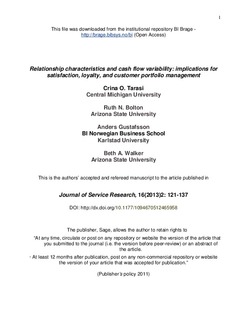Relationship characteristics and cash flow variability: implications for satisfaction, loyalty, and customer portfolio management
Journal article, Peer reviewed
Permanent lenke
http://hdl.handle.net/11250/93770Utgivelsesdato
2013Metadata
Vis full innførselSamlinger
- Scientific articles [2181]
Originalversjon
10.1177/1094670512465958Sammendrag
Service firms seek customers with high revenues, profits or lifetime value. However, they frequently ignore variations in consumption that lead to cash flow variability and adversely influence service operations and financial performance. This study shows that variation in individual customers’ consumption or spending on services can be decreased in ways that are actionable by most managers, without decreasing revenues or profits. Empirical findings are robust across two settings: telecommunications and financial services. Customer satisfaction has a “double-whammy” effect: lower cash flow variability and higher cash flow levels. This finding is important because firms can increase satisfaction in many ways. Second, customers who participate in loyalty programs have more variable cash flows, but not higher average cash flows. Hence, firms should design loyalty programs to improve customer satisfaction or intangible benefits (e.g., membership recognition), rather than offering economic incentives. Third, customers who purchase many different offerings, or allocate a large share of their purchases to the firm, have higher cash flow variability and higher average cash flows. Firms can optimize the customer portfolio by combining customers with high variability with customers who have different, offsetting cash flow patterns. Fourth, personal characteristics, such as age and income, also influence cash flow variability. The study describes sensitivity analyses of how different service and relationship marketing strategies influence a firm’s business outcomes. The article concludes with insights on how to integrate service management principles, which emphasize consistency or low variability in processes, with customer relationship management principles that emphasize growing relationships and cash flows.
Beskrivelse
This is the authors’ accepted and refereed manuscript to the article
